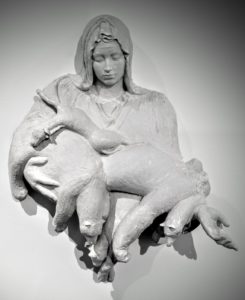By Larnie Fox
Special to the Herald
There is a show just installed at Arts Benicia – opening Saturday – that you need to see. It’s called Bay Area Clay – a Legacy of Social Consciousness. It is a true blockbuster, one of the most interesting and important shows Arts Benicia has produced in its 30-year history. It features work from the late, world-famous ceramic artist Robert Arneson and his students, and work from other Bay Area ceramic luminaries as well. It was organized by one of Benicia’s most successful artists, Lisa Reinertson, who was a student of Arneson.
Arneson was born in Benicia and made his home here until his death in 1992. He graduated from Benicia High, and worked as a cartoonist for the Benicia Herald. After earning an MFA from Mills, he became a high school art teacher. He went on to head the ceramic program at UC Davis, where he taught from 1962 until 1991.
During the ’60s and ’70s, Arneson and his peers pioneered Funk Art. Their work helped to free ceramics from being a purely functional craft, to being a fine art, on par with other forms of sculpture and painting. This does not mean that they abandoned craftsmanship – on the contrary, when you visit Arts Benicia, you will see some of the most rigorously well-crafted ceramics that you will find anywhere.
The real heavyweights of this show are the “first-generation” artists/teachers Arneson, Viola Frey, and Stephen De Staebler. Each of them have influenced generations of ceramic artists; Arneson heading the UC Davis ceramics department, Frey heading the California College of Arts ceramic department, and De Staebler teaching at the San Francisco Art Institute and SF State. The “second-generation” artists represented are not far behind in teaching thousands of students or in international acclaim. Artists represented include the head of San Jose City College’s ceramics, Michelle Gregor; Stan Welsh heading San Jose State University’s ceramic program; head of Solano Community College’s ceramics Marc Lancet; and Richard Shaw who chaired ceramics departments at the San Francisco Art Institute and then UC Berkeley until his retirement in 2012. All the artists included have generously given themselves to substantial teaching as well as exhibition careers, putting to rest the false notion that “those who can do, and those who can’t, teach.”
Curator and artist Lisa Reinertson says of the artists represented in the show: “They’re in museums around the country; they are established artists that are are well recognized internationally – but they come from the Bay Area – right here. Their legacy is teaching. These people have dedicated their lives to art and teaching, and the quality of this work is amazing.”
The show posed challenges for Arts Benicia and Reinertson. Shipping and handling huge, fragile clay sculptures is not easy, to say the least. Insurance costs have substantially increased. Arts Benicia has had to disallow photography, hire security guards, and tighten security in many other ways as well. They did receive a prestigious $10,000 grant from the NEA to cover expenses, but it requires $10,000 in matching funds. I’m sure Arts Benicia would appreciate any contributions to help them make their match.
This exhibition is not only important because of the status of the artists included, but more to the point – it is stunning. Besides being part of or influenced by the Funk Movement, you will see work that references Mayan and Aztec imagery like Mark Messenger’s massive sculpture “Cliffhanger,” Greco-Roman pillars in Arneson’s racially charged portraits, Chinese forms in Richard Notkin’s “hill jars” and Wanxin Zhang’s “What’s Up? II,” a figure reminiscent of the terracotta soldiers found buried in Shaanxi Province, China. Reinertson’s sculptures compete with anything produced during the Italian Renaissance. Ehren Tool’s very political cups reference everything from World War I propaganda, to the Venus of Willendorf, to Trump on CNN.
Even if you know (or care) little about art history, you will be blown away by the level of craftsmanship. Richard Shaw’s trompe l’oeil (fool-the-eye) vignettes look like they are made from wood, metal, paper, or even cigarette butts, but they are all made from clay with a little hand-blown glass.
Setting aside the craftsmanship and the historical importance of the work – the main thrust of the show is reflected in the subtitle: “A Legacy of Social Consciousness.” You will find very timely and very strong political statements in some of the work, but they never overshadow its artistic quality. As Richard Notkin writes in the (gorgeous) catalogue for the show: “For those of us who choose the role of the artist as activist, we should always remember that to be effective, we must primarily be artists. In other words, we should produce works in our chosen media that are first and foremost strong works of art.”
You will also find many “socially conscious” works that subtly challenge assumptions about gender, the environment, our treatment of animals, state the human condition, or celebrate the beauty of diversity.
Executive Director Celeste Smeland says of the show: “People will like it because the work is so beautifully executed and so creative in its concepts.”
“This is an exceptional exhibition,” she added. “We’ve made a commitment to put together a museum-quality show for the benefit of the community and to recognize the concept of this legacy.”
“Bay Area Clay – A Legacy of Social Consciousness,” is made possible in part by an award from the National Endowment for the Arts, a federal agency. The exhibition runs from Oct.14 through Nov. 19. Don’t miss the opening reception, this Saturday Oct.14, 6 to 8 p.m.
Larnie Fox is an artist and former executive director at Arts Benicia.







Leave a Reply